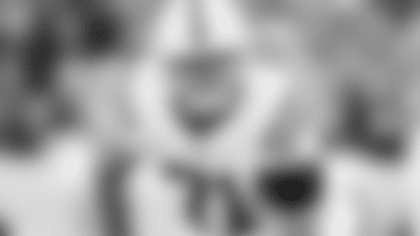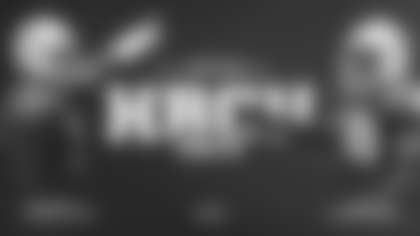
INDIANAPOLIS – Two years ago, Ryan Grigson sat on the top pick in the draft, though the suspense of that slot was lessened because of the excellence of Andrew Luck.
Indianapolis owned the 24th pick last year, and that certainly did not alter the seriousness with which Grigson approached the annual combine.
Any doubts about his intense gaze at this year's process without having a first-round choice would be dispelled by looking just above his desk.
"I never had time to put anything on my walls my first year as GM, but I did put up a big picture above my desk of Johnny Unitas, the famous picture of him rearing back to throw versus the Giants in 1958 Championship game," said Grigson. "I wanted our scouts, staff, coaches and everyone to see that picture when they came in my office because it signifies that you can unearth true greatness in the late rounds. He was a ninth-round pick."
Grigson heads into this week's combine coming off consecutive 11-5 seasons and playoff berths, the first Colts general manager to achieve that feat.
His first-round pick (26th overall) belongs to Cleveland after last September's trade for Trent Richardson, a move that will pay dividends as Indianapolis competes for a third straight post-season.
Indianapolis has selections in the second, third and fifth through seventh rounds (Cleveland also owns the Colts' fourth-round pick), and Grigson sees opportunity for newcomers to enter the program.
"It's not an exact science but as history shows, there are Pro Bowlers and even future Hall-of-Famers in every round and even after the draft," said Grigson. "That is a motivation for myself and my staff to identify the best players at each pick and hope they become what we are projecting them to be in our program."
Grigson's first draft class included Coby Fleener, Dwayne Allen, T.Y. Hilton, Vick Ballard, LaVon Brazill and others in addition to Luck, and those talents produced the most scrimmage yards of any NFL draft class in decades.
Last year's haul included Bjoern Werner, Hugh Thornton, Khaled Holmes and Montori Hughes (plus a healthy Josh Chapman from Grigson's first draft), but playing time was harder to come by in year two of the program's development.
This year's group could find the same dynamic when joining a team that has won 23 times in the past two seasons, but that is the aim of every general manager.
"It's a good problem to have when you are wondering if drafting a player at a certain position group will even make your team because of the depth," said Grigson. "You want to pick the best available talent on the board but also contrast that against that particular position group.
"If that position group is one big parking lot stacked with young talent then common sense would dictate you picking someone at another position (unless the talent is so glaring that you can't pass it up). Sometimes guys fall off the board and you just can't pass them up no matter how deep you are at a position."
Grigson turned over nearly 70 percent of the roster in his first season, pulling levers on more than 250 transactions.
The Richardson trade was his 16th since joining Indianapolis, and his non-stop personnel nature dates back to his playing days at Purdue.
As a Bengals rookie pick in 1995, Grigson surprised line coach Paul Alexander with his depth of knowledge on opponents, and that knack has only grown during his 15 seasons as an evaluator.
Embarking on his 17th combine, Grigson is eager to reach another checkpoint as he builds his third Colts squad.
"We have been entrenched in draft meetings as of late and there will be plenty of value there in round two," said Grigson. "You always have the potential to move players of value to acquire future picks or player for player if you are overstocked at a certain position group. It's just part of the business of getting better in the NFL."
Grigson will spend the next few days engaged heavily in the pursuit of bettering the Colts.














